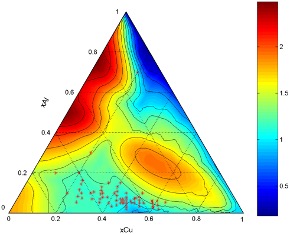Prediction of the Glass Forming Ability and the
Composition Range of the Dual Phase Nanocrystalline Aluminum Alloy
Libin Liu1*, Ligang Zhang1, Hong Bo2
1 Central South University, Changsha, Hunan 410083,
China
2 Yanshan University, Qinghuangdao, Hebei 066004, China
ABSTRACT:
Aluminum
alloy is an important structural material for aerospace and other light and
heavy-duty transportation vehicles due to its light weight, high strength and
good welding performance. How to further improve the properties of aluminum
alloy has become a research hotspot in the field of structural materials. The
strength of aluminum alloy can be improved by controlling the defects that
prevent dislocation movement. However, this strengthening effect cannot be
expanded indefinitely. Introducing too many defects will change the dominant
deformation mechanism from dislocation related process to defect softening
behavior, thus limiting the further improvement of material strength.
Amorphous is an effective way to improve the strength of aluminum alloy
materials. Recently, IFW Dresden of Germany cooperated with Institute of metals
of Chinese Academy of Sciences and Tohoku University of Japan to prepare bulk
aluminum alloy with the highest strength so far by combining the methods of
atomization preparation of amorphous powder and hot pressing preparation of
bulk materials. The yield strength and Young's modulus of the aluminum alloy
can reach 1.7GPa and 120GPa respectively at room temperature. The strength of
the alloy can reach more than 1GPa at 250 ℃. The reason for the high strength
of the aluminum alloy is that there are no grain boundaries and dislocations in
the amorphous structure. However, due to the softening effect of shear band caused
by shear stress concentration during deformation, the maximum stress that the
amorphous alloy can bear can only be limited to 2% strain.
The dual phase nanostructure may further improve the strength of Al-TM-RE
alloy. LV Jian et al. obtained magnesium
based ultra nano size biphasic materials with amorphous / nanocrystalline dual
phase structure by magnetron sputtering, which combined and strengthened the
advantages of nanocrystalline materials and amorphous materials, and showed
mechanical properties close to ideal strength at room temperature. The recent
development of a series of dual phase alloys (steel, high entropy alloy, etc.)
has further supported the development of nano size dual phase structure, which
may be one of the key technologies to improve the strength of alloys. These
research results also provide a new idea for the design of high-strength
aluminum alloy, that is, to improve the strength of aluminum alloy by using
amorphous / nanocrystalline dual phase structure. Parshanth et al. obtained
high-strength Al85Nd8Ni5Co2 dual-phase alloy by additive manufacturing method,
which still has strength of nearly 1 GPa at high temperature. The strength of
the nanocrystalline Al88Ni9Ce2Fe amorphous alloy obtained by Inoue et al. can
reach 1.5 GPa. The nanostructured phase in these alloys is Al11RE3
phase which is not coherent with the aluminum matrix. In Al-TM-RE alloy, a kind
of AuCu3 structure (L12) Al3RE phase will be
precipitated. This phase can form a coherent or semi coherent interface with
the aluminum matrix, which has the characteristics of high melting point and
good stability L12 amorphous aluminum alloy was used to further improve the
strength of the dual phase nano alloy.
In recent years, we used the
equilibrium alloy method and thermodynamic calculation method of phase diagram
to study the multi-component phase diagram of Al-TM-RE, and established the
thermodynamic database of phase diagram. On this basis, we predicted the
amorphous forming ability of each alloy system and the precipitation range and
composition of L12 structure nanocrystalline, which provided basic
data for the design of high strength dual phase nanostructured aluminum alloy.

Keywords: aluminum alloy; metallic glass; dual phase nanostructured material; thermodynamic calculation.

Libin Liu has completed his PhD at the age of 29 years from Central Southy University and Postdoctoral Studies from School of Mechanical Engineering, Chalmers University, Sweden. Now he is a Senior Professor of the School of Materials Science and Engineering, Central South University. He has published more than 100 scientific papers in reputed journals. He is a Fellow of Chinese Materials Research Society, Academic Member of the Phase Diagram Committee of Chinese Physical Society.